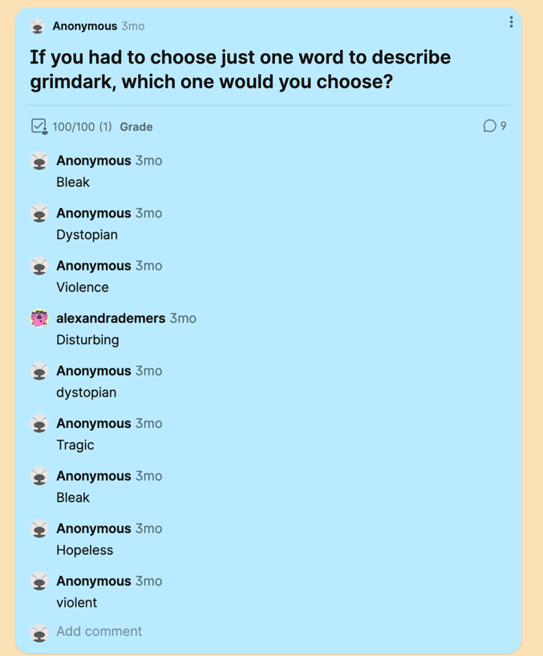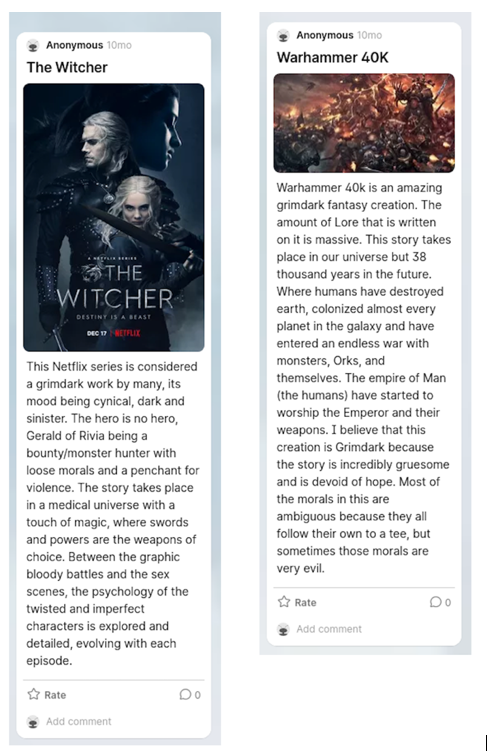With the idea of promoting student autonomy in mind, I was looking for a way to develop a more student-centered approach to teaching. This is when I discovered Padlet, a versatile online platform. I then began to explore the different ways to incorporate it into my teaching practice as an English as a Second Language (ESL) teacher. One way I have been using this highly engaging platform is in my 604-103-MQ course (Culture anglaise et littérature) to introduce a new literary genre. There are, however, a multitude of ways to implement it into your teaching practice at the college level, no matter what your discipline is!
Promoting learner autonomy
In the last few years, I realized that the way students learn today is very different from how we used to learn. Indeed, most of us learned with a more teacher-centered approach, where the teachers were the source of knowledge. They would present all the information without considering the background knowledge of students. However, nowadays, the learning process must be significant to the students to motivate them.
I started reading about the concept of learner autonomy (Little, 1991) while working on my PhD. With the idea of giving students more control over their learning, I started thinking about how to make my teaching more about them, how to put the control in their hands.
My 1st idea was to replace all the steps of a traditional lesson:
- presentation (how to present the content)
- practice (how to consolidate the knowledge)
- production (what they can produce with the content)
To do so, instead of me presenting them the content, I wanted them to look for it and present it to each other. That’s when I discovered the true power of Padlet!
What is Padlet
Padlet is a tool used in schools worldwide, especially if they embrace cooperative learning. The concept is relatively easy. Padlet is an online platform used to create visual boards. All students can write and publish content on a board. Therefore, they work together to create a collaborative board, and construct meaning together.
Padlet’s free version allows you to have up to 3 active padlets. You only need to deactivate your padlets once you’ve used them (by moving them into the archive section) to free up space for new padlets. If you wish to have more options, other paid subscription plans are offered to suit your needs.
Using Padlet to introduce literary genres
One way I use Padlet in class is to introduce literary genres to my students in my English Literature course. A good thing about Padlet is that, as a teacher, you can decide on the level of control you want to give your students. In my case, I decided to give students control over the content by focusing on a specific literary genre, Grimdark, since that was the genre I would teach that semester.
Using Padlet was a way for me to encourage them to use their own background knowledge on the topic, find their inner motivation, and show the more advanced students that they can still learn something from the others, even if they already have a good knowledge of the topic.
The whole lesson on the Grimdark genre was broken down into 3 main steps, allowing the students to create their own presentation, practice, and production.
Step 1: Presentation – Researching on a literary genre
This 1st padlet was all about the presentation stage of the lesson, as they presented the content among themselves using a collaborative board. I asked the students to get in groups of 4 to research the Grimdark literary genre:
- its history
- influential authors and works
- distinctive characteristics
I created the 1st padlet and shared it with my students using the link. Each group could then post the content of their research on the board.
The teacher’s role at this stage is one of an editor, making sure that the content created by the student is accurate and providing feedback.
Step 2: Practice – Creating a check test
Once the 1st step completed, the practice stage encourages the students to create their own check test, to consolidate their knowledge.
Working in the same groups, students:
- come up with 5 questions based on the content of the 1st padlet
- discuss the questions with teacher guidance and choose the 10 most original ones to be posted on a 2nd padlet.
At this stage, students practise and reinvest their knowledge by answering the 10 questions we have selected. Selecting the questions allows me to ensure they are varied and to steer the students toward questions that are more open-ended or more interesting to answer.
If I see a mistake in the answers, I encourage peer review and intervene only if the correction is not successful. Once again, the teacher and students can use the comments section to give feedback or explain an answer.

An example of a question included on the check test (2nd padlet) created by students, based on their knowledge of the Grimdark literary genre.
Step 3: Production – Creating their own padlet
For this 3rd part, I encourage them to create their own padlet. They have to register on the platform, which gives them a chance to become familiar with it, so they can use it later on for any other collaborative work.
Now that they know more about the genre, its authors, features, and characteristics, the students:
- focus on a work of their choice (series, book, movie, etc.)
- develop 3 arguments why they believe this work fits the genre
This step requires them to use their critical thinking skills. They can compare and contrast with other works.

2 examples of a production Padlet created by students, displaying their choice of work and arguing how it fits with the Grimdark genre.
Once they have created their own padlet arguing in favour of their Grimdark work, the team will share their padlet with the other students. To do so, a feature on the platform allows you to create a sharing link. You can either use the Moodle forum feature or a shared Google Doc to group all the links in one place. This way, the students can easily find each other’s padlet. I ask them to look at the work of others and give their own opinion using the comments. I always remind them to use constructive comments.
At the end of the production stage, I look at everything, all the padlets and all the comments, and I give feedback. Once again, my role as a teacher is one of a facilitator, guiding them through their learning process.
Empowering education through Padlet
As a teacher, think about all the time you might spend planning a lesson. This is the big advantage of using Padlet; it lightens your workload. There is no need to spend hours creating a PowerPoint Presentation or a practice test. The students do all the work by themselves. It obviously changes your role as a teacher as you become a mediator, walking around the classroom and guiding them through their learning. At the end of the day, all you have to do is provide feedback. In addition, since it’s mostly group work, revising the padlets is not time-consuming.
Moreover, I was finding it very hard to deal with students at the college level since their level of motivation was very low. The moment I changed my teaching to a more student-centered approach, geared toward learners, I noticed a significant change in the students’ engagement and motivation. They are now all engaged, all the time, because they are always on task. They are not sitting around waiting for the teacher to give them a choice. They become active learners, and I’ve seen them getting really excited about the work! Realizing they learn differently changed my experience as a college teacher.
In addition, Padlet fosters their creativity. They can be creative by posting links, videos, and more. The platform offers so many possibilities. I’ve even seen students filming themselves disguised as a character, such as the Witcher! I always stir their creativity as much as possible and encourage them to go beyond what we see in class. They usually want to make their padlet nice and visually attractive. Even the low achievers, those who used to do the bare minimum in class projects, get engaged and come up with original and excellent postings.
Padlet at your fingertips
If you want to try Padlet in your classroom, there are a few things to consider before implementing it in your teaching practice.
The first thing I suggest you do is have a look at the platform before anything. It is user-friendly and intuitive, but many features are available, and you need to see which ones are best suited for your learning objective and discipline.
For example, you might want to choose the most appropriate format. I’ve shared one way I introduced it in my classroom using the wall format with sections. Still, Padlet offers different organization methods:
- Wall (brick-like layout)
- Stream (top to bottom feed)
- Grid (rows of boxes)
- Map (points on a map)
- Canvas (content connected or scattered)
- Timeline (horizontal design)
I’ve also presented how I use it in a literature course, but there are multiple ways you can use it in any language course. For example, you could easily use it to cover grammar points. It is easier for students to understand the rules if they are the ones posting them.
Another way to use it in a language course would be as reading comprehension activities. For instance, if the story is about an adventurer, you could use the map and record the character’s actions in every place they went. It is an effective way to verify the student’s understanding of the story. Once again, you can also give some control to the student and put them in charge of creating the questions.
In any case, consider how you can apply it to your discipline. If you teach history, you can certainly make use of the timeline grid format. If you teach geography, why not use the map? It’s all about creativity!
Then, decide on the degree of freedom you want to give them, depending on your reality and learning objective. Keep in mind that the more freedom you give, the longer the activity is going to last. If you have a very busy syllabus, you might want to reduce the degree of freedom by providing guiding questions.
Finally, before diving into it with your students, make sure to give them a quick tutorial on the different features Padlet offers and how to create a posting. Then, get the ball rolling!
How do you envision implementing this tool in your discipline? Using Padlet has changed how I teach in a good way. I’m always on the lookout for new ideas to incorporate it into my teaching or activities geared towards learner’s autonomy, so feel free to share your experience below!



Congratulations Bruno! I admire the way you have adapted the tool to get students motivated in your topic. I mention in passing that some teachers have also used it for tandem language learning. It’s asynchronous but can also be used for video posts.
Hi Bruno, I enjoyed reading your article about Padlet. I just started using it this semester and so far have been really enjoying it. The feedback I received from my students was positive and I really liked the collaborative feel it created!
Would it be possible to send me your presentation so that I can present it a my collègues in our ESL department meeting? I think it could really change the way we are teaching and positivity impact our students.